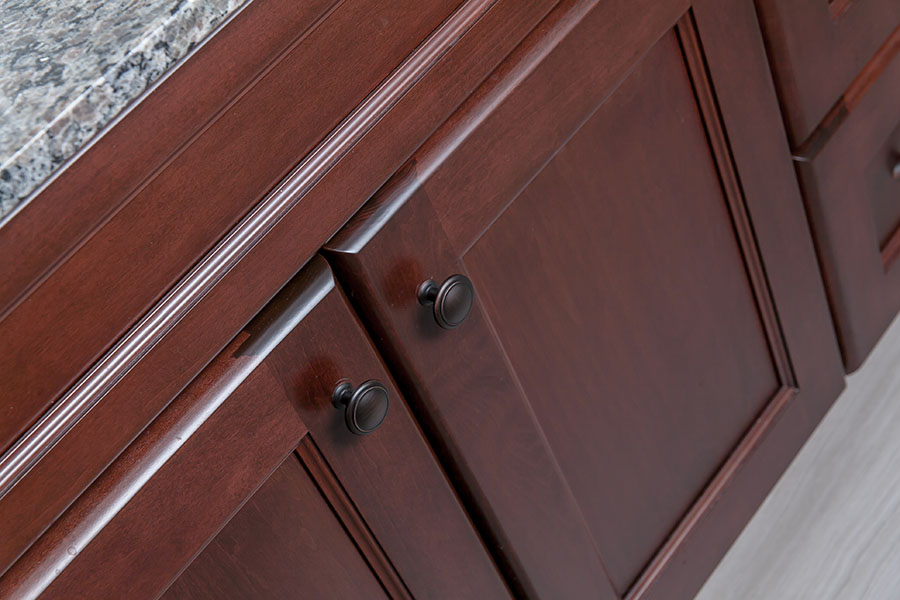
Choosing the perfect bathroom vanity can be a daunting task, but when you factor in different materials, it can be even more difficult. Whether you’re fully renovating your bath or simply updating your decor, you will need to consider what is best for you, your home and your wallet. While choosing the first cheap, attractive vanity you see may be preferable, it would do you well to do a little research (or just read this article!). Most vanities or cabinets will likely be made of Particle Board, MDF (Medium Density Fiberboard), Plywood or Solid Wood.
So, let’s compare.
Particle Board:
This is a composite sheet material made by combining wood particles with glue and then heated and pressed into sheets. It can be covered with wood veneer, melamine or laminate. Particle board products are classified by their particle size and overall density; some stronger than others. The benefit of particle board is price. It is inexpensive to produce and buy; however, it can sag under the weight of a solid surface countertop, such as granite or quartz. Another downside to particle board is the fact that it can be damaged VERY easily by water and, most importantly, steam. At first, you may not realize how much steam comes into contact with your vanity. Every time you shower, take a bath, or even have the hot water running for more than a few seconds, your vanity is subject to steam. This will cause the material to break down, and you will need to replace your vanity prematurely. In the end, particle board is not recommended for bathroom vanities.
MDF:
MDF or Medium-Density Fibreboard is an engineered material made from composite wood pieces and fibers, which are held together with either a wax or resin adhesive. It is similar to particle board; however, it is much denser and does not contain the “voids” visible in particle board. The benefits of MDF include price as well as the smooth surface. You won’t find knots or splinters around edges, which means it takes paint extremely well. There are, however, drawbacks to using MDF. If left unfinished and it gets wet, it will swell and disintegrate. Also, there’s a chance it could release formaldehyde; a known carcinogen. Painting the MDF, however, will seal it thus preventing any off-gassing. So, if you’re looking for a painted vanity, this could be the way to go.
Plywood:
Plywood is made from veneers of wood glued into layers that form sheets. Like particle board, this product comes in a variety of thicknesses and qualities. On the low-end, soft woods, quick dry glues, and voids can be often found between the layers. This plywood is usually coated with a plastic that has a wood grain pattern applied because the wood they use isn’t very attractive and may not finish well. On the high end however, it is a very attractive wood and a truly solid choice (no pun intended) for your bathroom vanity. It will rarely degrade. While you want to be cautious of water damage with all types of woods, high end plywood has a pretty high success rate in terms of holding up for a long period of time. Some people question a vanity that has plywood on the sides or back and wonder if solid wood would be a better choice. In reality, it’s not. The plywood will be more stable over the long run than solid wood. That is because the plywood will not expand or contract to moisture/humidity/temperature changes like solid wood does. If covered in veneer, it will be as stable as solid wood and will not chip/peel except under unusual circumstances. Plywood is an excellent choice for bathroom vanity materials.
Solid Wood:
While nothing really compares with solid wood in most projects, it may not ALWAYS be the best choice for a bathroom vanity. Solid wood comes in two variations; solid wood (all natural real wood) and solid hardwood. Solid hardwood is the most durable wood material and is make from woods like oak, cherry and maple. Solid wood has the tendency to expand and contract as humidity changes. Expansion can cause cracks in the painted finish and also warping (in extreme cases). Real wood is porous in nature so it will absorb water molecules in the air. However, I daren’t say that real wood is a bad material. It’s been used for centuries and is still the preferred option by many contractors and builders. The strength and durability of solid wood is why many choose it for vanities, so it really depends on what you find most important. By keeping humidity in control, most homeowners won’t have any problems with this beautiful material. It works best with a natural or stained finish.
Happy Remodeling!
